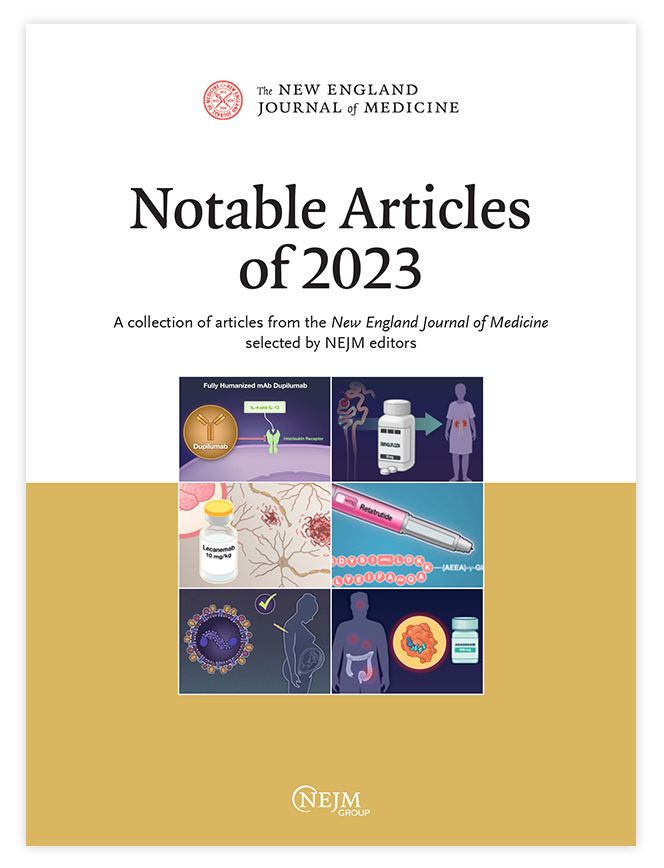Mepolizumab to Prevent Exacerbations of COPD with an Eosinophilic Phenotype.
IF 96.2
1区 医学
Q1 MEDICINE, GENERAL & INTERNAL
引用次数: 0
Abstract
BACKGROUND Mepolizumab is a humanized monoclonal antibody that targets interleukin-5, a cytokine that plays a central role in eosinophilic inflammation, which is present in 20 to 40% of patients with chronic obstructive pulmonary disease (COPD). METHODS In a phase 3, double-blind, randomized, placebo-controlled trial, patients with COPD, a history of exacerbations, and a blood eosinophil count of at least 300 cells per microliter who were receiving triple inhaled therapy were assigned, in a 1:1 ratio, to receive mepolizumab (at a dose of 100 mg) or placebo subcutaneously every 4 weeks for 52 to 104 weeks. The primary end point was the annualized rate of moderate or severe exacerbations. Secondary end points, tested hierarchically to control for multiplicity, were moderate or severe exacerbation as assessed in a time-to-first-event analysis, measures of health-related quality of life and symptoms, and the annualized rate of exacerbations leading to an emergency department visit, hospitalization, or both. RESULTS Of the 804 patients who underwent randomization, 403 were assigned to receive mepolizumab and 401 to receive placebo. The annualized rate of moderate or severe exacerbations was significantly lower with mepolizumab than with placebo (0.80 vs. 1.01 events per year; rate ratio, 0.79; 95% confidence interval [CI], 0.66 to 0.94; P = 0.01). The time to the first moderate or severe exacerbation was longer with mepolizumab than with placebo (Kaplan-Meier median time to the first moderate or severe exacerbation, 419 vs. 321 days; hazard ratio, 0.77; 95% CI, 0.64 to 0.93; P = 0.009). Between-group differences in measures of health-related quality of life and symptoms were not significant; thus, no statistical inferences regarding subsequent secondary end points in the statistical testing hierarchy were made. The incidence of adverse events was similar in the mepolizumab and placebo groups. CONCLUSIONS Treatment with mepolizumab led to a lower annualized rate of moderate or severe exacerbations when added to background triple inhaled therapy among patients with COPD and an eosinophilic phenotype. (Funded by GSK; MATINEE ClinicalTrials.gov number, NCT04133909.).Mepolizumab预防嗜酸性表型COPD恶化。
mepolizumab是一种针对白细胞介素-5的人源化单克隆抗体,白细胞介素-5是一种在嗜酸性粒细胞炎症中起核心作用的细胞因子,存在于20%至40%的慢性阻塞性肺疾病(COPD)患者中。方法:在一项3期、双盲、随机、安慰剂对照试验中,接受三次吸入治疗的COPD患者,有加重史且血液嗜酸性粒细胞计数至少为每微升300个细胞,按1:1的比例,每4周接受mepolizumab(剂量为100 mg)或安慰剂皮下注射,持续52至104周。主要终点是中度或重度恶化的年化率。次要终点,分级测试以控制多样性,是在首次事件发生时间分析中评估的中度或重度恶化,健康相关生活质量和症状的测量,以及导致急诊就诊、住院或两者兼有的恶化的年化率。结果在804名接受随机分组的患者中,403名患者接受mepolizumab治疗,401名患者接受安慰剂治疗。mepolizumab组中度或重度加重的年化发生率显著低于安慰剂组(每年0.80 vs 1.01;比率比,0.79;95%置信区间[CI], 0.66 ~ 0.94;p = 0.01)。mepolizumab组到第一次中度或重度恶化的时间比安慰剂组长(Kaplan-Meier中位时间到第一次中度或重度恶化,419天比321天;风险比0.77;95% CI, 0.64 ~ 0.93;p = 0.009)。与健康相关的生活质量和症状测量的组间差异不显著;因此,在统计检验层次结构中,没有对随后的次要终点进行统计推断。mepolizumab组和安慰剂组的不良事件发生率相似。结论:在嗜酸性粒细胞表型的COPD患者中,mepolizumab治疗与背景三重吸入治疗相结合,导致中度或重度加重的年化率较低。(GSK资助;MATINEE ClinicalTrials.gov号码:NCT04133909)。
本文章由计算机程序翻译,如有差异,请以英文原文为准。
求助全文
约1分钟内获得全文
求助全文
来源期刊

New England Journal of Medicine
医学-医学:内科
CiteScore
145.40
自引率
0.60%
发文量
1839
审稿时长
1 months
期刊介绍:
The New England Journal of Medicine (NEJM) stands as the foremost medical journal and website worldwide. With an impressive history spanning over two centuries, NEJM boasts a consistent publication of superb, peer-reviewed research and engaging clinical content. Our primary objective revolves around delivering high-caliber information and findings at the juncture of biomedical science and clinical practice. We strive to present this knowledge in formats that are not only comprehensible but also hold practical value, effectively influencing healthcare practices and ultimately enhancing patient outcomes.
 求助内容:
求助内容: 应助结果提醒方式:
应助结果提醒方式:


